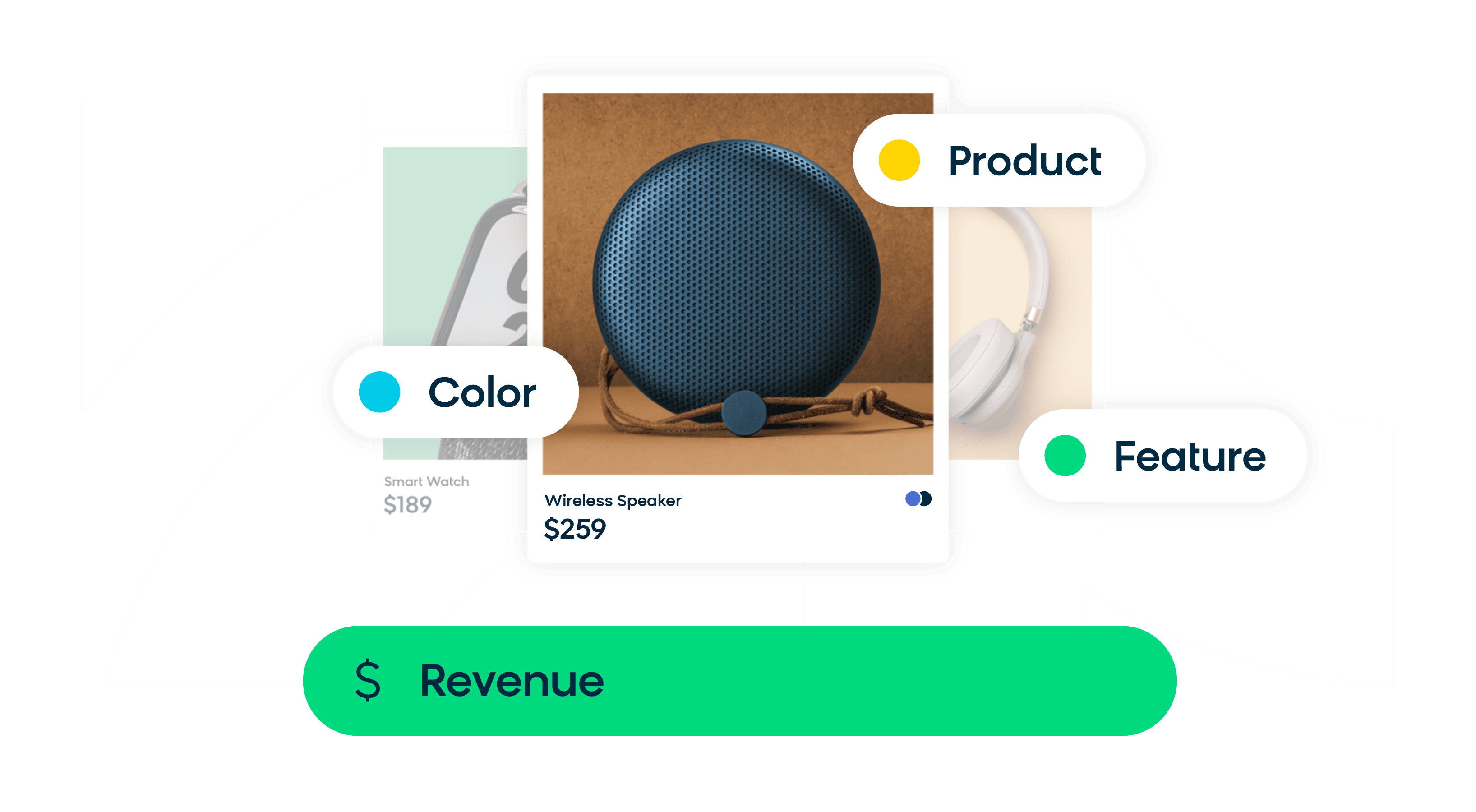Introduction to Ecommerce Site Search
Ecommerce businesses know that their success hinges on their ability to provide visitors with quick and easy access to the products they are looking for.
Incorporating an effective site search tool into your online store can be a powerful way to drive revenue both immediately and in the long run. Consider the data below pulled from Bloomreach Commerce Pulse that speaks to the rise in online traffic since the pandemic.
The data says it all. Shoppers are seeking products online more since the pandemic changed the shopping habits of so many consumers.
One of the main benefits of using an ecommerce site search tool is that it allows shoppers to quickly find what they are looking for without needing to manually browse. Having an effective site search engine on your website will help visitors find relevant results right away, as well as improve your overall user experience, which can lead to increased conversions and more sales for your business.
When choosing a site search solution, it’s important to consider which features are most beneficial for your specific business. From advanced search tools like autocomplete, relevance boosting and related searches, different strategies can be leveraged depending on the needs of each individual business. With this knowledge in mind, companies can select the best site search tool to display relevant content to site visitors.
Having an effective internal site search engine is essential in order to provide customers with fast access to relevant content while helping generate revenue both immediately and in the long term. By leveraging advanced features from top site search tools, companies can create tailored experiences that boost customer loyalty over time and maximize return on investment (ROI).
In short, everything on your website starts with site search and specifically who is powering your site search platform.
All Ecommerce Priorities Start With Search
In a world of comparisons, it can be difficult for business leaders to take a strategic approach to their priorities and pinpoint exactly where to start investing or which solution will provide the most long-term stability and short-term gains. They might ask themselves: Which one is needed now? Will we see results in three months? Or in over a year?
When it comes to website investments and improvements, there are many routes you can take as a business. Depending on who you ask in your department (or larger organization), these options are as vast as they are subjective. The good news is that such a phenomenon is relatively normal for any business. Different stakeholders have varying priorities, business objectives, and opinions, but it’s vital to come to a joint consensus for organizational growth and to enable future investments.
According to a recent Gartner study, 90% of surveyed marketing leaders believe that evolving digital commerce capabilities can be done through “aggressively expanding their investments with a particular focus on digital-first value creation and customer experience.” These investments typically fall into the following categories and subcategories:
Marketing and Advertising
- Brand Building – While a website is essential to your marketing strategy, there are a lot of assets that go along with building and maintaining it. Many businesses continue to make investments in clean, attractive collateral, which is becoming the norm in today’s increasingly digital landscape. Brand building increases lifetime value, boosts conversion rates, and attracts customers. Because your company establishes trust with your shopper or buyer by providing them with a smooth purchase journey from the first inquiry to the transaction, an investment in search contributes to your brand just as much as any brand-building activity.
- Digital Marketing – For years, tech introspectives have been writing about the digital marketing bubble finally bursting. Since customer acquisition costs (CAC) have increased 60% in the last six years, marketers are reevaluating their primary acquisition channels and the strategies behind campaign distribution. Modern-day tools that marketing teams once used to target audiences are no longer considered effective, ethical, or even legal in certain geographies. Thus, businesses across all verticals are reconsidering their investment dollars in these areas and looking at alternative approaches to build an organic SEO strategy, improve conversions, and boost revenue — like site search functionality that gives customers relevant results.
- Data Storage and Improvements – Product data needs enriching descriptions, multiple images, and correct taxonomy and categories. Typically living in Product Information Management (PIM) or Enterprise Resource Planning (ERP) systems, cleaning up product data might mean a new PIM, or hiring an agency to reorganize or enrich it. A lot of businesses put off site search because they believe that search engines can’t work to product accurate search results if the product data is bad. With a custom site search solution, you can fill in the gaps within your product data by using autosuggest, auto-generated synonyms, and auto query relaxation features, while you fix your product data. You don’t need a complete ecommerce replatform first!
Logistics and Fulfillment
- Self-service Tools – Self-service tools have been gaining traction on and off over the past 20 years. As employment numbers and operating budgets hit record lows, the pandemic reignited businesses’ interest in these solutions. Whether you’re setting up AI-powered chat and messaging features, creating a knowledge base or help center, or building an app specifically for your brand, self-service tools lead to faster customer resolutions, lower labor costs, and a more efficient, cohesive experience across departments. As it relates to problem-solving, advanced site search tools are considered a self-service tool in their own right because it allows the customer to self-assist and find the right product or service.
- Fulfillment and Shipping – If your business deals with products, you might feel the need to be like Amazon. We’ll admit that Amazon’s business model of constant availability, quick fulfillment, and two-day shipping is a tough one to beat. The “Amazon standard” is what it is today because of the company’s uncompromisingly convenient business model that’s focused on the customer. But your business doesn’t want to lose customers by only thinking about the transactional piece of commerce — it’s all about creating end-to-end, personalized shopping experiences that begin with good site search.
Website Experiences
- User Interface/User Experience (UI/UX) – Shoppers are likely to leave a site if it’s unattractive, slow to load, or difficult to navigate. A good UI/UX strategy will help your ecommerce website avoid these faux pas and adapt to any device via responsive design so your website visitors can have an optimal experience. While UI/UX is a crucial investment, certain tech solutions — like site search — contribute to “good” and “bad” digital experiences and allow you to essentially solve multiple problems in one fell swoop.
- Personalized Experiences – Third-party data once fueled ecommerce personalization. The General Data Protection Regulation (GDPR) and other governing compliance statutes had other plans for these approaches, however. Even though consumers support data privacy and protection, they still want personalized experiences. 61% of survey respondents believe on-site personalization has the most potential to drive growth for their business, and we see no coincidence that site search and guided navigation rank right below it at 57%. Personalization capabilities within your search and merchandising tool will allow merchandisers to foster meaningful and relevant experiences in an online setting through upsells.
- Site Search – By investing in a top-tier site search solution, you’ll guide the seeker to the transactional portion of their journey where they can convert into a customer. If you truly see your business as part of the seeker-centric movement, you’ll need to eliminate any frustrations for your prospects, beginning with this very important ecommerce priority. Site search can be optimized through the search bar, category pages, and product recommendations with the right enterprise search software.
The Four Engines of Good Product Discovery
The questions to ask yourself at this point are: Are you focusing on the right ecommerce initiative(s) at this time? Do your current tech vendors align with your business goals? What steps can you take to consistently drive cash flow and increase revenue in both the short and long term? Site search addresses all of these questions.
Offering site search is an industry standard, but the way you lay out your search result, category, and product pages has a significant impact on revenue per visit (RPV) and other key metrics in your ecommerce strategy. Plus, 75% of US online adults agree that it’s important for retailers to offer advanced site search features that return accurate search results.
We’ve talked about some of the ways site search can find its way into your ecommerce priorities. Here’s a deeper dive into the nuts and bolts (a.k.a. the “engines”) of a relevant and personalized search experience:
Relevance
Your ecommerce team members have a lot to consider daily. Not only do they need a deep knowledge of the products your business offers and all of their unique attributes, but they also have to organize all the data points of your customers to seamlessly bring the two together. Artificial intelligence (AI) helps your search bar understand your products on a deeper level and present them in ways that make sense to your customer. Then, the AI learns from consumer behavior to become smarter over time. This unique combination of natural language processing (NLP) and machine learning (ML) is referred to as “semantic understanding,” which provides a relevance engine to customers who are tired of seeing irrelevant results. Smart semantic search is needed in today’s marketplace.
Optimization
Combined with the relevance engine of semantic search, an optimization engine will cut out unnecessary tasks, automate your digital merchandising workflows, and result in a serious return on investment (ROI). Think of all the hours spent boosting and burying your products or creating synonyms for product attributes. An advanced search solution runs in the background the entire time and significantly reduces redundant workflows — even though merchandisers can also intervene in the smart, strategic, and streamlined ways they see fit.
Personalization
Irrelevant search results still plague customers today. Although they seek end-to-end, personalized experiences online, this promise remains unfulfilled by many brands. Your search experience should be built for the seeker’s motivations behind their purchase, and the tool behind it must fully grasp consumer intent and present all relevant options on the proper channels. This personalization engine will learn from user behavior and site interactions to create 1:1 personalization.
Customization
Ecommerce brands need a site search tool that can be customized to their goals. A good search tool is optimized out of the box, but will also improve search analytics over time based on insights from individual user preferences and site-wide product signals. Top-notch product search technology is also designed to scale and handle evolving traffic requirements, API callouts, and product catalogs to become the ultimate customization engine for your business.
The Short- and Long-Term Impacts of Investing in Search
Can you believe we narrowed all those ecommerce priorities down to a singular one with this much impact? That’s the thing about site search — there is just so much potential that lies beneath the search bar. At the same time, your team of product experts knows all of the subtleties of your offerings and client base. Analytics and insights come together with human judgment to create amazing commerce experiences that are data-driven, but still human at their core.
Now that you have a more technical understanding of search, you’ll most likely want to evaluate its benefits for your business. Let’s take a closer look at the ones we’ve come across and how they’ll positively affect your business’ revenue — both now and later.
Short-Term Impacts (The Now)
Promoting Efficiency Across Teams
Not all shortcuts are bad, including automation. After all, Google search changed the world. And who is more deserving of a shortcut than some of the most overloaded personnel at your company? These team members should spend their time building features and improving processes, as opposed to chasing down requests. Yes, we’re talking about developers. A worthwhile site search tool will release the pressure valve on this historically overburdened department and put the power back in the hands of merchandisers. In fact, intelligent site search will optimize a merchandiser’s workflows by allowing them to make changes more quickly and efficiently.
Improving Conversion Optimization
When you think about offering the right product to the right customer at the right moment, it seems like an impossible task. In the past, we relied solely on humans to make these impactful decisions to progress the purchase journey. By bridging the gaps between product data, complex queries, and in-depth customer understanding with AI, you’ll bolster your merchandising strategies, promote personalized recommendations, and keep shoppers on the page. Better yet, you won’t have to rely on a single person or team to carry out the often time-consuming process of conversion optimization.
Enhancing Customer and Buyer Experiences
The overall objective of commerce experiences is to entice a customer to make a purchase. To do that, you need to engage them across all channels, inspire them with targeted content, and convert them with relevant search and product recommendations. It all begins with your search bar identifying the proper results and prioritizing and personalizing them for the consumer. By reducing null or unrelated search results, you’ll eliminate annoyances that impede the crucial beginnings of many customer journeys. Since potential customers, who are searching for designated terms and phrases, often know what they want, the worst thing you can do is drop the ball on site search and compromise the entire experience.
Long-Term Impacts (The Later)
Establishing a Stable Channel for Revenue
Profitability is as rewarding to achieve as it is crucial to your company’s health. Not only are you concerned about it as a head of your department, but your C-suite is also focused on optimizing the business for profitability. With all the ways search can generate a short-term gain, it is a natural trajectory for it to become a stable channel for both new and recurring revenue. Since it is a tool focused on increasing conversions of high-value products and services, search technology points your prospects in the desired direction and promises a strong ROI.
Weathering Future Disruptions in the Market
The sad reality is that pandemics, worker shortages, war, climate change, fuel costs, and inflation are all factors that greatly influence how you conduct business, the talent and tools you gain and retain, and the purchases your consumers make. For modern-day businesses, pivots aren’t a one-time occurrence. They will happen again and again. If the pandemic has taught us anything, it is that companies need to prepare ahead of time, so they can adapt to endure when the next hardship inevitably surfaces. With agile inventory updates and comprehensive product information, an advanced site search solution provides an exceptional product discovery experience and improves customer loyalty, helping companies remain profitable in uncertain times.
Furthering Total Digital Transformation
As we all have learned over the past two and a half years, it is simple to ditch digital strategy until it becomes necessary, but it’s hard to pick back up if you leave it behind. Digital transformation isn’t only about your brand’s online presence; it should permeate every aspect of your business from sales processes and marketing workflows to — you’ve guessed it — product discovery. Although algorithms have advanced exponentially, locating products or services online is the same as it was 20 years ago in many ways. When it comes to finding relevant information, the consumer ultimately takes on a lot of responsibility to locate what they need or want. This makes product search a necessary ecommerce investment, especially if your brand is set on building a successful, long-lasting digital transformation.
Making the Argument for Your Company’s Future
Now that we’ve made the argument for site search, it’s your turn to do the same. Sure, it would be incredible to stumble upon a new digital solution, mention it once during a Zoom call, and get instant approval to invest, but let’s be realistic. Since you know that search can provide true value to your business, it’s up to you to champion the solution to the stakeholders and implementation experts involved in the decision-making process.
These colleagues will not always understand the value right off the bat, and you’ll need to build a solid case for buy-in. First, you will need to argue that search is the right investment for your company at this time. Then, you’ll have to narrow it down to a single vendor, while understanding what site search tools cost. Finally, you must answer the following question for key decision makers: Why this solution, and not another competitor?
Even though the ball is in your court, we don’t want you to go into the big game unprepared — or even alone. After all, planning and preparation will be a huge factor in taking your search solution of choice from ideation to implementation. Here are three checklists we’ve prepared to help you to make the argument for product search as your next ecommerce innovation project:
CTO or CIO
The Chief Technology Officer (CTO) or Chief Information Officer (CIO) will likely not have the same asks as some other members of your C-suite. Their focus will be on the implementation of the tool, as well as regular maintenance and security precautions. Even though they might not hold financial control, they are one of your main influencers on the project and could possibly be your most difficult to convince since they’re thinking about the entire digital transformation — as opposed to search as just a single application or CX improvement.
To help them see the big picture, you’ll need to have this information ready for your next meeting:
- Make sure the search tool is integration agnostic, so it will work well with the rest of the business’ tech stack (i.e., SaaS, API-first architecture that allows for composability)
- Gather the “Total Cost of Ownership” (i.e., licensing costs, costs to maintain, and costs to upgrade) of the tool to ensure it suits Engineering or IT’s criteria and/or budget
- Jot down everything about the site performance and speed of the chosen search solution (remember, this ultimate IT metric centers around on-site performance, speed, and uptime)
- Ensure that the search solution is “developer-efficient” (i.e., fewer requests from colleagues and the business, faster time to live)
CFO
Many people think of CFOs as faithful to archaic processes and out of the loop with the latest technology, but they are just as aware of the need to digitally transform as any other leader of your C-suite. Still, you won’t have to worry as much about the technical aspects of your purchase with the CFO as you did with the CTO or CIO. They’ll be more concerned with the cost of the tool fitting into the department budget and the potential revenue that it could return. Because of labor costs, however, the CFO could also show interest in a sensible implementation timeline. Once they understand the ROI that a search tool can provide, we’re sure they’ll be completely satisfied with your decision to move forward.
But it’s still important to prepare these items below to further demonstrate the value of a site search solution:
- Nail down all the overall costs of a search tool (i.e., licensing fees, costs of API capacity, maintenance and update fees, and additional costs for training or customer support)
- Have a proper grasp on the ROI of a search solution and consider highlighting vital metrics, like revenue, RPV, and efficiency
- Make sure that the search tool is scalable to accompany business growth and can support a larger product catalog to avoid vendor churn, costs of evaluating a new tool, etc.
CDO
Now, here is the member of the C-suite who probably understands your pain points better than anyone: the Chief Digital Officer. However, you shouldn’t let their experience prevent you from formulating a worthy case around search technology as your next investment. After all, they’ll expect you to properly illustrate all the reasons that you think it’s the best ecommerce initiative to focus on right now, despite the hundreds of possibilities available on the market. Like you, they’ll need to learn that all great commerce experiences begin with product discovery. So, just make it crystal clear that findability can fuel real revenue growth, and you’ll be in the money. Literally.
Before joining forces with your biggest C-suite advocate, make sure that you have the following:
- Demonstrate how the search solution can span both online and offline channels, connecting all the dots of the purchase journey to make it more cohesive from acquisition to the transaction
- Show case studies from your search tool vendor of choice to properly illustrate its ability to hit important KPIs (i.e., conversion rate, AOS, RPV, etc.)
- Focus on how the search tool increases customer acquisition, customer lifetime value (CLV), and other seeker-centric metrics beyond profitability (Please note: CDOs care just as much about creating digital experiences as they do about generating revenue)

Make the Case for Product Search to Your C-Suite
15% of your site visitors using the search bar make up 45% of your revenue. So how can you make it a top priority?
Don’t Take Our Word for It — Let Us Prove It to You!
It’s easy to continue talking about how beneficial site search is to your ecommerce brand’s bottom line, but what’s more powerful than the numbers behind those assertions? Bloomreach has gathered a lot of valuable data from our A/B tests, so if words aren’t enough — and in business, they’re often not — let these numbers speak to the value of Bloomreach Discovery.
HD Supply Invests in Product Search and Impacts Revenue
HD Supply wanted to move the needle on digital transformation, feeling like it was lagging along with many other companies in the industrial distribution space. Yet, unlike many others, HD Supply’ was eager to go against the grain and redefine its business model. The company deployed its ecommerce team to analyze how B2B buyers interacted with the brand online. The US distributor concluded that it must improve its product discovery process for buyers, making site search the obvious investment priority.
Knowing that using as much out-of-the-box technology as possible would avoid heavy customization down the line, HD Supply decided to invest in Bloomreach Discovery — which also allowed the ecommerce team to customize when necessary. Understanding that HD Supply’s buyers wanted to complete purchases without a second thought, Bloomreach helped revamp the company’s site search experience and added the ability to “add to cart” directly from the search bar. Now, HD Supply’s buyers see the product image, part number, and price from the search bar, while being able to add directly to their cart from the same, centralized place. Due to these changes, HD Supply experienced a 16% increase in revenue from search, as well as a 4% increase in add-to-cart rate.
Conclusion
Though it often gets taken for granted because many of us can’t remember living without it, site search is a valuable tool. It’s just so easy to turn to your device and ask a search bar about the prodding questions and curiosities currently bugging you the most. It’s no different for business leaders and innovators — we want solutions for all the obstacles we face, especially in an age of disruption.
But in today’s market, it’s not so much about recognizing the issue and finding a solution. The bottleneck is the decision-making process for company leaders: Which issue is most important to address first, and what vendor can our company choose to improve our chosen ecommerce initiative? Like you need to make the case for the C-suite, we — at Bloomreach — hope we’ve made the case for you regarding product search. Site search solutions, like Bloomreach Discovery, are easy to implement and even easier to use.
According to our many validated A/B test results, ecommerce brands experience a 5 to 10% lift in RPV. It also lessened workloads by 30 to 50% fewer hours, giving your ecommerce team the ability to discover insights, diagnose issues, and create personalized customer journeys and experiences with concise, manageable workflows. The best part of Bloomreach Discovery? You can continue to scale it as your business grows and flourishes — driving more revenue now and later.
It’s Not a Claim. It’s a Promise.

Strengthen your case for Product Search by getting a free search impact validation assessment from Bloomreach.



